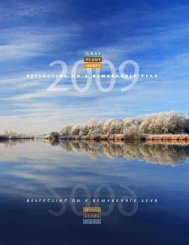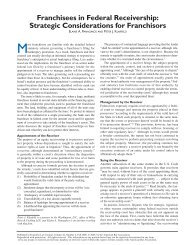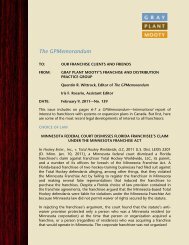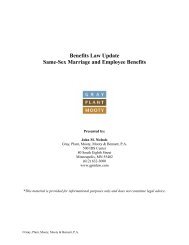Los Angeles Lawyer October 2008 - Gray Plant Mooty
Los Angeles Lawyer October 2008 - Gray Plant Mooty
Los Angeles Lawyer October 2008 - Gray Plant Mooty
Create successful ePaper yourself
Turn your PDF publications into a flip-book with our unique Google optimized e-Paper software.
of the individual at issue. 17 Fourth, clients may<br />
not be billed for the cost of necessary accommodations.<br />
18<br />
A lawyer or firm need not make a specific<br />
policy or practice modification or provide<br />
an auxiliary aid or service if it “would fundamentally<br />
alter the nature of [the] services….”<br />
19 Similarly, an auxiliary aid or service<br />
is not required if it “would result in an<br />
undue burden.” 20 However, the fact that one<br />
option would result in an undue burden does<br />
not necessarily eliminate the obligation to<br />
ensure effective communication. There is<br />
likely an alternative auxiliary aid or service<br />
that would not result in an undue burden or<br />
fundamental alteration but would ensure<br />
effective communication to the maximum<br />
extent possible.<br />
There are three categories that define<br />
when the ADA designates a hearing impairment<br />
as a covered disability:<br />
1) The hearing impairment substantially limits<br />
a major life activity. For example, hearing<br />
constitutes a major life activity.<br />
2) The impairment substantially limited a<br />
major life activity in the past. For example,<br />
a client’s hearing was substantially impaired<br />
in the past but is now improved due to surgery<br />
or an assistive device.<br />
3) The hearing impairment is viewed as substantially<br />
limiting. 21 For example, clients may<br />
use an assistive device—and thus their hearing<br />
is no longer substantially limited—but<br />
the clients nonetheless may be treated differently<br />
because they are believed to be substantially<br />
limited.<br />
California law includes a similar but somewhat<br />
more expansive definition of disability.<br />
A disability need only “limit” rather than<br />
“substantially limit” a major life activity in<br />
the state. 22 The second and third categories<br />
of the ADA definition are the same in<br />
California law. Under federal law, mitigating<br />
measures—such as hearing aids, cochlear<br />
implants, or other devices that improve hearing—must<br />
be considered in determining<br />
whether an individual has a disability under<br />
the ADA. 23 Under California law, mitigating<br />
measures may not be considered. 24 Under<br />
either federal or California law, measures<br />
that compensate for hearing loss, such as lip<br />
reading or sign language, are not considered<br />
mitigating measures.<br />
Because hearing loss encompasses a wide<br />
range, it is often difficult to tell whether an<br />
individual has a covered disability or not.<br />
However, regardless of whether a person is<br />
covered under state or federal law, it is essential<br />
for lawyers to communicate effectively<br />
with their clients.<br />
Complying with Legal Obligations<br />
Effective communication with deaf and hardof-hearing<br />
clients is possible, but lawyers<br />
should make sure they avoid a few traps.<br />
First, do not simply ask a client or potential<br />
client to bring a relative to a meeting. It is a<br />
common misconception that individuals who<br />
are deaf or hard of hearing and communicate<br />
using American Sign Language (ASL) have<br />
ASL-fluent family members. California service<br />
providers are often confused about this issue<br />
because they ask family members to interpret<br />
with non-English speakers—where no accommodation<br />
is legally required. However, using<br />
family members to interpret for the deaf and<br />
hard of hearing is not advised, except in an<br />
emergency, because often family members<br />
are not fluent in ASL and because legal services<br />
present unique confidentiality and conflict<br />
issues.<br />
Lip reading, while helpful to many, has<br />
problems as well. Even skilled lip readers are<br />
not 100 percent effective. This can cause significant<br />
communication breakdowns and will<br />
normally require additional communication<br />
aids. Similarly, using pen and paper may<br />
seem like an appropriate strategy, and it may<br />
be the cheapest means available, but it is not<br />
reliable. Productive and essential communication<br />
cannot be conducted simply via handwritten<br />
notes.<br />
However, reasonable and effective resources<br />
are available. These should be chosen<br />
based on the needs of the individual and the<br />
communication necessary for a transaction.<br />
Because of the nature and complexity of legal<br />
services, it is critical that lawyers consider and<br />
plan ahead so that a client, or a prospective<br />
client, understands the lawyer’s advice and the<br />
lawyer comprehends fully the client’s needs.<br />
The following tools can help lawyers not<br />
only establish better communication with<br />
clients and potential clients but also provide<br />
any legally required accommodation. 25<br />
Sign Language and Oral Interpreters.<br />
Under the ADA, interpreters are required to<br />
be “qualified,” or fully ASL-fluent and able<br />
to completely interpret what is being said<br />
and being signed. This includes using the<br />
correct terminology for the situation. 26 No<br />
specific certification is required, but an interpreter<br />
must be fluent. Interpreters are available<br />
commercially, and it is desirable to find<br />
interpreters experienced in interpreting legal<br />
issues. Oral interpreters silently enunciate<br />
the speaker’s words and use facial expressions,<br />
gestures, and articulation to help people<br />
who lip read understand every aspect of<br />
the proceedings.<br />
Video Remote Interpreting (VRI). This<br />
method involves a computer with an Internet<br />
connection, a webcam, and a telephone line<br />
to provide services similar to a live interpreter.<br />
The deaf person and interpreter communicate<br />
via sign language through the webcam.<br />
The lawyer or staff person speaks to the<br />
interpreter via the telephone. The remote<br />
interpreter then interprets as a live interpreter<br />
would.<br />
VRI has advantages and disadvantages.<br />
A poor Internet connection may result in a<br />
breakdown of communication. For this reason,<br />
VRI is not guaranteed to meet the<br />
ADA’s “effective communications” standard.<br />
Communication is generally better<br />
with a live interpreter. However, VRI can be<br />
less expensive. If a lawyer or organization<br />
meets the undue burden standard, which<br />
would make providing a live interpreter<br />
impossible, VRI can be used as a limited<br />
substitute.<br />
Video Relay Service (VRS). VRS allows<br />
deaf individuals to use video phones to connect<br />
directly with another deaf person using<br />
live ASL through a video connection. VRS<br />
offers a visual equivalent of a telephone call.<br />
It can also be used to connect to a relay operator<br />
and through that operator to a hearing<br />
person over the phone. VRS is free to both<br />
parties and is subsidized by the federal government<br />
as a way to ensure deaf access to the<br />
hearing phone system.<br />
Using VRS can be a good way for lawyers<br />
to communicate in ASL with their clients.<br />
However, legal providers should know that<br />
VRS is not intended as a substitute for live<br />
interpreting, and VRS operators are not<br />
allowed to interpret between two people in the<br />
same location. Also, under the ADA, individuals<br />
with disabilities may not receive less<br />
desirable treatment to avoid accommodation<br />
costs. A lawyer may not refuse to have an inperson<br />
meeting with a deaf client to take<br />
advantage of free VRS rather than pay for an<br />
interpreter when the lawyer would have met<br />
with a hearing client in person under the<br />
same circumstance.<br />
Computer Assisted Realtime Translation<br />
(CART). A stenographer or CART specialist<br />
uses software and equipment to produce<br />
instant speech-to-text translation to a computer<br />
monitor or other display, enabling an<br />
individual to read the transcript of the proceedings<br />
as it occurs. CART can be effective<br />
for individuals who are deaf, do not use ASL,<br />
and use speech to communicate, and for people<br />
who are hard of hearing.<br />
CART may be used live with a stenographer<br />
at the location or remotely via the<br />
Internet and a telephone line. Some remote<br />
captioning services can be less expensive<br />
than live captioning, but the appropriateness<br />
of either method depends on the circumstances.<br />
Assistive Listening Systems/Devices<br />
(ALS/ALD). These devices transmit amplified<br />
speech by a variety of methods that differ in<br />
their transmission mode and installation.<br />
Some of these systems are permanent installations,<br />
and others are devices that can be used<br />
temporarily.<br />
16 <strong>Los</strong> <strong>Angeles</strong> <strong>Lawyer</strong> <strong>October</strong> <strong>2008</strong>







